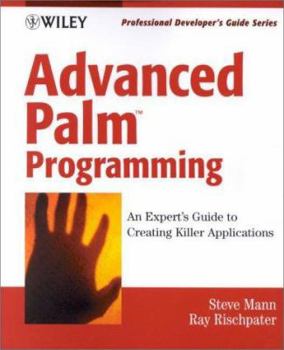Advanced Palm Programming: Professional Developer's Guide
Graduate to the next level of Palm programming Advanced Palm(TM) Programming Professional Developer's Guide If you've been looking for an expert guide to Palm programming that goes beyond the basics,... This description may be from another edition of this product.
Format:Paperback
Language:English
ISBN:0471390879
ISBN13:9780471390879
Release Date:January 2000
Publisher:Wiley
Length:400 Pages
Weight:1.56 lbs.
Dimensions:1.0" x 7.5" x 9.2"
Customer Reviews
4 ratings
A Buffet for the Advanced Developer
Published by Thriftbooks.com User , 23 years ago
Frequent questions I encounter while developing for the Palm platform include, how do I work with floating point numbers? How do I do graphics? How do I add an appointment or address book entry into the Palm database? If you've gone past the basics of Palm programming and have these kinds of questions, "Advanced Palm Programming" is for you. For example, when I wrote a calculator program, I wish I had the chapter on floating point conversion and formatting. The PalmOS is designed to be compact and efficient and therefore, doesn't support floating point very well. Mann and Rischpater present routines with 15 digit precision, localization, and left and right alignment.Regarding graphics, the authors discuss bitmaps, and panning and zooming techniques. If you're looking for sample video games, you'll have to look elsewhere. The authors frame their discussion with mapping software.The chapter on reading from and writing to Palm's native databases (address, datebook, todo, memo) is interesting. While some developers have done this by studying Palm's source code (like myself), the authors offer an alternative API they call a property interface. This API hides the internal details, simplifies the task, and generally saves time. If Palm changes the underlying database schema, the API will isolate those changes and prevent your code from breaking. But you will have to depend on the authors to update their API, or know enough of the internals to update it yourself. I haven't worked with the API enough to render a verdict. There is one other way to write to Palm's address, datebook, and todo database that the authors did not mention: use the vCalendar and vCard format. These public formats, however, are no help when it comes to reading the databases.The book covers many other advanced topics so be sure to check out the table of contents. Most of the examples require Palm OS 3.1, Codewarrior 6, and the Palm SDK 3.5. Unix and the gcc toolchain are not used in this book. Nevertheless, the writing is clear, as are the examples, so developers on Unix can still benefit.
Great tool for Palm programmers!
Published by Thriftbooks.com User , 23 years ago
This book is an excellent tool for experienced programmers learning Palm OS and wanting to get real code running fast. It is also a great reference for programmers that know the Palm OS. I particularly like the book is organized, it is easy to find examples that solve problems at hand.
The book you were looking for...
Published by Thriftbooks.com User , 23 years ago
Being disappointed from "Palm Database Programming" und "Palm Programming - the developer's guide" which were all useful at the beginning but very fast became extremely superficial (Half of Palm database programming describes the use of Satellite forms and the configuration of SQL!!) I discovered that this book really rocks. It helps you with the solutions to concrete real world problems you encounter and guides you around mistakes every programmer made at some time ;)It has not only complete, easily readable sourcecode but also describes the structuring of an application for a certain task from the abstract problem up - and this for every single chapter. That is, you have 8 completely functioning applications and not only 8 stages of one boring one (as in O'reilly's ;). Extremely helpful was the java application to build Palm databases on the desktop which saved me a lot of time.If you know the API already and C is your language - this book is for you.
What you can do after you do "Hello World"
Published by Thriftbooks.com User , 23 years ago
This book puts meat on the bones of the Palm OS. The topics cover the standard Palm OS information and put it in the context of practical applications. It goes well beyond the "Hello World" basics and delves into issues that the experienced Palm programmer needs to know. For example, the book includes a section on progress dialogs in the context of a sample application. It explains how to use the Palm OS Progress Manager and gives sample code. But, and here where the book really shines, it points out the weaknesses in the Palm implementation (works only with Palm OS 3.0 or newer, etc.) and offers a much better alternative, again with sample code. An experienced programmer can copy and paste the code to implement advanced Palm OS functions in hours rather than days.




